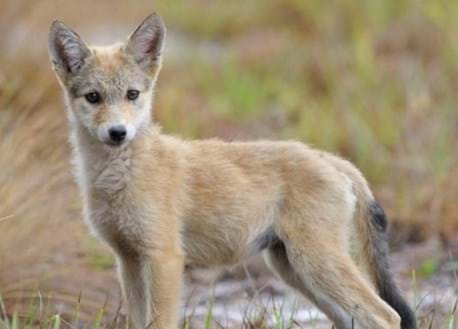PHOTO CREDIT: Florida Fish and Wildlife Conservation Commission
I recently attended a presentation of the Volusia County Extension Office. Dr. Raoul Boughton, University of Florida, presented a program about coyotes and their effect on Florida ranches. University of Florida presents great programming for the public, and for a naturalist, it’s a great way to add depth to what we know.
The coyote (Canis latrans, var. Eastern) branched off from the eastern and red wolf approximately 150,000 years ago. Because they are closely related, coyotes and wolves overlap in range. Coyotes and red wolves can interbreed. Although red wolves are twice the size of coyotes, they are at risk of becoming outbred because there are so many more coyotes than red wolves.
Characteristics
Coyotes can be quite dark in color but are usually grayish-brown or yellow-ish brown, with lighter underparts. They have large upright ears and long muzzles with black noses. Their eyes are yellow. They hold their tails down when they run, unlike dogs, who hold their tails up. Like wolves, they have bushy tails.
Life Cycle
Adult coyotes in Florida range from 30-50 pounds and are usually about 40 pounds. Each year, female coyotes can produce a litter of 6-8 pups, of which only 4 or 5 will survive the first year. Coyotes are not as pack-oriented as most other canids, but a mother and her daughters may remain together in a loose pack.
Range in Florida
First documented in north Florida in the 1930, by the 1990s, they could be found south of I-4, and by 2011 have been observed as far south as Key Largo.
Their average home range is 16 square miles, with males having a larger range. They may travel 20-25 miles a day and are most active after 6pm and before 8am. They most often prefer improved pasture – ranchlands – with males preferring open areas and females preferring scrub and shrubby areas. This is likely because females are often traveling with their young.
Across the United States, coyotes have been successful in increasing their range. While some of this is due to their ability to cover a lot of area and their high reproductive rate, human attempts to rid the landscape of eastern and red wolves allowed the coyote to take advantage of the resources once used by those animals.
Coyote and Cattle
Of 38 cattle ranchers surveyed, 43% had directly observed a coyote attack or kill calves, and 90% reported indirect evidence. Coyotes are not believed to attack adult cattle. Attacks of calves occur with greatest frequency in the late fall and winter, when new calves and placenta are likely to be on the ground. In a study where researchers were able to identify exactly when cows and calves were in specific pastures, coyotes were not found to select the pastures with cattle over pastures without cattle.
When multiple calves are taken by coyote, it is generally one or two opportunistic animals which returns to take another calf every few nights. While this is certainly not good for either the ranchers or the calves, it does not appear that coyotes are widely preying on calves.
Studies of coyote stomach contents do not show cattle, and indeed, a large part of the coyote’s diet is grass and leaves! Nearly 10% of the stomach contents in the coyotes examined were anthropogenic, that is, coming from human activity (fast food wrappers, etc.). These were coyote from wildlife management areas; it is likely that urban coyotes would show an even higher percentage of this anthropogenic material.
What if You See a Coyote?
The best advice is to adopt strategies that will make it unlikely that you’ll ever be close to one. Don’t feed them! Pet food left outdoors and even seed left around bird feeders can attract coyotes, so clean it up. Make sure that garbage and compost bins are secured.
If you are in close proximity to a coyote, it is highly likely that you can scare it away. Florida Fish and Wildlife Conservation Commission (FWC) recommends waving your arms and yelling to get the coyote to retreat. They suggest continuing to wave and yell until the animal has completely left the area. You may use noisemakers to scare them away.
Keep in mind that animals will be bolder when protecting their young. However, a coyote that appears to have lost its fear of humans may be a hazard to itself and humans. If a coyote approaches people, or chases jobbers or bikers, or attacks a leashed pet, it should be reported. You can use the FWC reporter app or call the nearest FWC Regional Office.


Great article! So glad you are putting information out there to help educate people about wildlife in our area and how to safely live and protect others.